The answers to these questions lead one to a diagnostic tree of things
to try. It is much like a doctor talking to a patient, establishing a
history of that person's path that lead you to the doctor's office that
day.
For example, if a drive will not spin up but you can feel the motor
trying to spin with these little tick-tick-tick and can feel the torque
of the motor, then you are about to spend a whole lot of money because
recovering that data involves a clean room environment that is way
beyond all but the top professional recovery labs. More on that in a
bit.
This drive...
Did spin (Yay!)
Was recognized by the system .... sometimes.
As soon as you tried to access it, the drive sounded like it powered
itself off and started to spin down, then about 1/2 second later spun
itself back up. The system wouldn't see it for about 20 seconds, then it
could see the drive. This cycle would repeat forever.
Unfortunately, I could not read any data without the drive getting
itself confused, slowing, and spinning back up. It sounded like the
drive was rebooting itself whenever you tried to access it. I tried a
few tricks of the trade, but there was no improvement in the drive's
condition.
Prognosis:
Not good! The report back to the client wasn't
great news - in fact, to minimize any data loss, at this point I
recommended sending the drive to a company I partner with that
specializes in data recovery. They have the proper clean room
environment, replacement parts, and skills / knowledge to actually
remove the data platters from a dead drive and put them into another
where they can be read. If the problem were due to head damage, this is
the only way to recover that data.
I established an RMA with the company and received the paperwork.
It is impossible to know what it is going to take to recover the data
or even if it is recoverable without them receiving the drive and doing
their own analysis. They charge $65 for this initial step, and on
average data recovery costs a minimum of $700 and can be $2000 or more,
not including shipping, priority handling (if required), or my labor to
remove / replace / reinstall the system and get the data back onto the
fresh computer.
So your out the door is going to start at $1000 but likely be higher,
possibly as much as $3000.
If your data can be recovered ... Some of it might not be if there
was damage to a platter or data was overwritten by other attempts to
repair the system. And if not recoverable, kiss it all good bye forever.
Do you see why I preach "back-up your data"?
After that
bit of news... Upon hearing that, the client was
not happy. His question was, could it be recovered any other way. As in
"Cheaper?" I'd done my cursory analysis and determined there is a
hardware problem but did not isolate it. As a doctor, the first rule is
"Do no harm" so I limited what I did to things that were likely not
destructive to the data.
I offered to spend some more time poking at it. I knew from my
attempts to get data from the drive that it was running quite hot. In
fact, so hot as I'd put another fan blowing on it while working just to
keep things cool. Heat is enemy #3 for electronic components. The #1 and
#2 slots go to "Liquid" and "Dropping on the floor". While dropping
won't hurt a chip, it will do quite a lot of damage to internal parts
that aren't designed to handle 100Gs of force. Hard drives don't like
being dropped either, but that is another story.
But from this point forward, if I did mess around with the hardware,
there is a chance I might render things completely unrecoverable. The
client was willing to take that risk, deciding that at $1000-3000 he
would rather lose the data than pay for its recovery.
A careful
visual inspectionI believed there was a good chance
the data on the drive wasn't totally cooked, but just the controller
board. As luck would have it, I happened to have one of those same
drives in a server here. I put the two side by side, the good drive on
the left and my client's dead drive on the right - you can click on the
image below for a full-sized view:
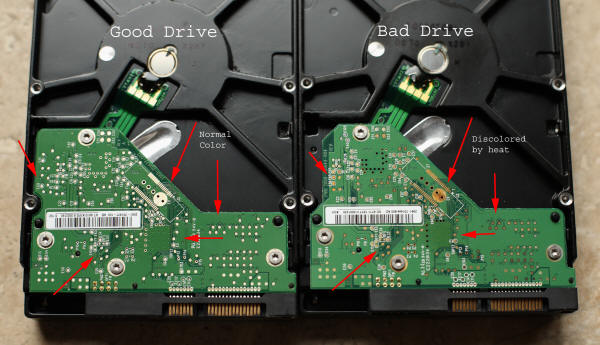
If you look at the circuit pads and compare the ones on the left I
pointed to with the red arrows with the similar pads on the right, the
ones on the right are discolored which is an indication of a lot of
heat. Even though these were both Western Digital WD5000AAJS drives
manufactured within 2 days of each other (02 Dec 2007 on the left, 04
Dec 2007 on the right) in the same factory, you can see there are
differences in the drive controller boards.
My hope was the controller was cooked but the data on the drive was
still good and readable.
My other hope was that the known good controller board would talk to
the dead drive's motor and platters the same as the dead board did. No
guarantees there - they are clearly different designs and could
implement completely different and not compatible methods of talking to
the heads / platters. If swapping boards works or not is a gamble and
all in Western Digital's hands.
Drum roll
please...After moving the good controller board to
the dead drive, hooked everything up - applied power (no smoke!), and
connecting it up to the recovery system with an empty drive ready to
catch anything that might be important and readable ...
The drive came up, was recognized, was readable, and had a good file
system on it!
From there it is a race - can you get all your data off the drive
before it decides to crap out again. If the board was damaged because of
poor airflow and cooling in the system, I could likely read everything
for a long time at a leisurely pace. If the drive internals have a
problem where it drew so much current through the circuits of the
controller and that is why fried the old controller then this will
likely happen to the replacement controller - so I'm on a tight clock,
rescue data off from most important to least important before the whole
thing smokes the replacement controller.
If you are under the clock like that, you don't know it until things
have failed. So you operate like you are on an unknown clock and get as
much as you can as quickly as possible and hope you got enough so you
aren't sending the drive for a $3,000 recovery.
And in the
end
This story has a very happy ending.
With some strategic cooling, I was able to get all the important data
off this drive. Client was happy. He did spend around $600, which
included a new & bigger hard drive with all his data back on it. Way
less than shipping it off to the recovery specialists.
Just for fun
I was curious if I could bring the drive back to life -
looking at the back side where the controller makes contact with the
electronics inside the drive itself, here are two shots of a connector
before and after cleaning it with a pencil eraser:
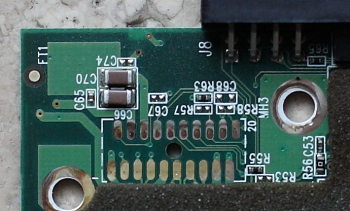 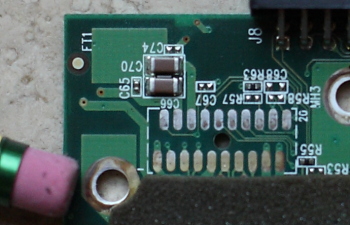
Left is before, right is after - see the discolored by heat contacts?
Tried cleaning them and re-assembling the dead drive (after getting all
the juicy data off it, of course!) and ... unfortunately, the drive
still wasn't working. Not that I would trust it if it did work, but I'm
showing this to give a small hint at some of the many failed paths one
often takes before they find the path that works.
This controller card is fried. And even if I had a new one, I won't
trust this drive at all, especially when a double size new drive can be
had for $70.
It is good for puling out the very powerful magnets - maybe another
article? If you want super powerful magnets, take one of these apart -
you will be amazed!
Not a typical
data recovery
This was an unusually complicated recovery. Most of the
time, the drive itself is still working but has data errors on it, or
has had critical sections trashed by some program and I can use software
tools to scan and find most of the important files, sometimes rebuilding
those critical areas by hand.
In fact, this is the first time I've written about a data recovery
operation as this was not typical. I've recovered data from camera flash
drives, USB sticks, and many many hard drives over the years. I even
took a video of one broken drive that became readable when I moved it in
a particular pattern. There is a link to the video near the bottom of
the Cool Stuff page, if you are curious.
So the moral of this story? Back up your important data!
Every hard drive is an electro mechanical piece of equipment which will
eventually fail and try take all your data with it to the grave.
Data loss is totally preventable and for a minimal cost. I do not
subscribe to the "backup data into the cloud" - you will pay more, get
less, and depending on your upload bandwidth and how much data you have
might never be able to transfer it all. Plus, getting it back might take
weeks. But that is another article.
2 TB external hard drives are now around $100. This should be more than
enough storage for 95% of the people out there. Cheaper if you can go
with 1 TB. Both these are clipped from Micro Center, 1/17/2013:
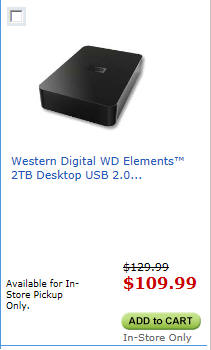 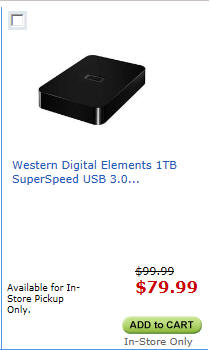
Get two, one on your desk and one you keep at someone else's house and
rotate them every month or two so you'll have an off-site backup. Why
off site? What happens if your house burns down. Or if thieves come in
and steal your computer along with the nice backup hard disk sitting on
top of it?
Backup is cheap insurance against having to pay for data recovery, which
is very is expensive. Or data loss, which might be impossible to
replace.
Happy backing up!
David Soussan
|